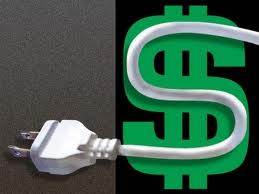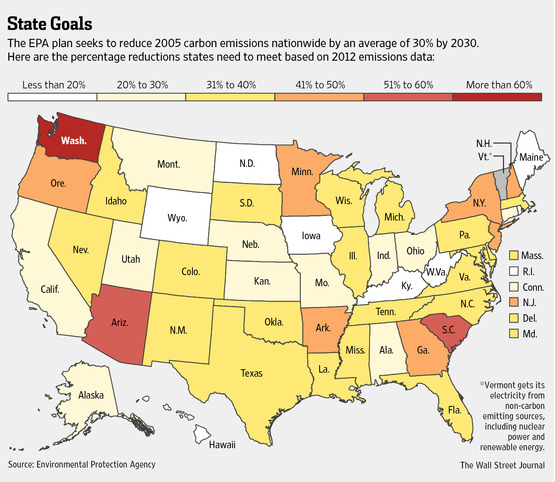Your electric bill will skyrocket with new energy regulation
Daily News Article — Posted on June 5, 2014
NOTE: On Monday, June 2 the Environmental Protection Agency (EPA) released a long-expected rule proposal that seeks by 2030 to reduce America’s carbon dioxide emissions 30% from 2005 levels. The primary mechanism for the reduction will be tough emissions limits on coal-fired power plants. The effect of the rule will most likely be the dramatic expansion of natural gas as a fuel for power generation. When burned, gas emits just half the carbon of coal.
 (from an Associated Press story at NY Post) NEW YORK – Electricity prices are probably on their way up across much of the US as coal-fired plants, the dominant source of cheap power, shut down in response to environmental regulations and economic forces.
(from an Associated Press story at NY Post) NEW YORK – Electricity prices are probably on their way up across much of the US as coal-fired plants, the dominant source of cheap power, shut down in response to environmental regulations and economic forces.
New and tighter pollution rules and tough competition from cleaner sources such as natural gas, wind and solar will lead to the closings of dozens of coal-burning plants across 20 states over the next three years. And many of those that stay open will need expensive retrofits [to comply with new regulations imposed by the Obama administration].
 Because of these and other factors, the Energy Department predicts retail power prices will rise 4 percent on average this year, the biggest increase since 2008. By 2020, prices are expected to climb an additional 13 percent, a forecast that does not include the costs of the environmental [regulations unveiled by the Obama administration on Monday].
Because of these and other factors, the Energy Department predicts retail power prices will rise 4 percent on average this year, the biggest increase since 2008. By 2020, prices are expected to climb an additional 13 percent, a forecast that does not include the costs of the environmental [regulations unveiled by the Obama administration on Monday].
…State governments and industry are struggling to balance this push for a cleaner environment with the need to keep the grid reliable and prevent prices from rocketing too much higher.
“We’re facing a set of questions that are new to the industry,” says Clair Moeller, who oversees transmission and technology for the Midcontinent Independent System Operator [MISO], which coordinates much of the electric grid between Minnesota and Louisiana.
Coal is…used to produce 40 percent of the nation’s electricity, more than any other fuel. Because it is cheap and abundant and can be stored on power plant grounds, it helps keep prices stable and power flowing even when demand spikes.
Natural gas, which accounts for 26 percent of the nation’s electricity, has dropped in price and become more plentiful because of the fracking boom. But its price is on the rise again, and it is still generally more expensive to produce electricity with gas than with coal. Also, gas isn’t stored at power plants because the cost is prohibitive. That means it is subject to shortages and soaring prices.
During the brutally cold and snowy winter that just ended, utilities in several states struggled to secure natural gas because so much was also needed to heat homes. Some utilities couldn’t run gas-fired plants at all, and power prices soared 1,000 percent in some regions.
As Indiana has reduced its reliance on coal to 84 percent from 97 percent over the last decade, its power prices rose far faster than those of its neighbors and the rest of the country.
That makes things tough on customers, especially big power users like Rochester Metal Products Corp., in Rochester, Indiana. The hulking furnaces it uses to melt scrap iron consume enough electricity to power 7,000 households.
“As Indiana’s price of electricity becomes less and less competitive, so do we,” says Doug Smith, the company’s maintenance and engineering manager.
Burning coal releases toxic chemicals, soot and smog-forming chemicals, as well as twice the amount of carbon dioxide that natural gas produces. The Supreme Court last month gave an important approval to one Environmental Protection Agency clean-air rule. That cleared the way for a new rule… announced by President Barack Obama [this week].
This rule, the first to govern emissions of carbon dioxide from existing power plants, will accelerate the move away from coal – if it survives the legal and political challenges that are sure to come.
Already, the current rules are expected to force power companies to shut down 68 coal plants across 20 states between 2014 and 2017, according to Bentek Energy, a market analysis firm.
The Energy Department estimates coal plants with the output to supply 33 million homes will close by 2020.
“We haven’t operated at those low levels (of generation) for at least 30 years,” says MISO’s Clair Moeller.
To meet high demand this past winter, American Electric Power, which serves 5 million customers in 11 states, needed to run 89 percent of the coal plants it will soon have to shut down, says AEP CEO Nick Akins.
This raises concerns that the power system soon won’t have enough wiggle room to handle extreme weather, making blackouts more likely.
“It’s a warning of what may be to come,” Moeller says.
EPA administrator Gina McCarthy, responding to critics, notes that pollution also imposes costs on the economy because it harms human health and the environment. And she has also forcefully promised that the coming carbon dioxide rule will keep costs in check and power flowing.
“EPA is not going to threaten electric reliability,” she told a gathering of executives in Houston in March. “That is our No. 1 priority.” …
Associated Press. Published at NYPost .com on May 21. Reprinted here for educational purposes only. May not be reproduced on other websites without permission from the Associated Press. Visit the website at ap .com.
Background
Global warming is an important issue to understand. The theory that man’s use of fossil fuels (burning coal, oil and gas for energy, which produces carbon dioxide, or CO2) is causing an imminent catastrophic change in the climate – global warming – is believed to be true by many scientists, climatologists, citizens, the mainstream media and Hollywood celebrities, and was made popular by former Vice President Al Gore’s movie “An Inconvenient Truth.” and called "a fact" by President Obama. People who believe in this theory say we must reduce the amount of carbon dioxide produced by limiting/reducing the amount of fossil fuels we use, or by purchasing offsets (carbon credits).
The belief that man’s activities are NOT causing an imminent catastrophic change in the climate is held by many other scientists (see MIT’s Professor of Meteorology Dr. Richard Lindzen’s commentary in Newsweek). This view is very unpopular in the media and widely condemned by those who believe man-made global warming is fact. See Newsweek magazine’s online presentation “The Global Warming Deniers.” Those who do not believe man is causing the global temperature to rise don’t believe it is necessary to reduce the production of CO2 by reducing our use of fossil fuels or to purchase carbon offsets.
- Greenhouse gases are components of the atmosphere that contribute to the greenhouse effect. Some greenhouse gases occur naturally in the atmosphere [water vapor, which is the most abundant], while others result from human activities such as burning of fossil fuels such as coal, oil and gas. Greenhouse gases include water vapor, carbon dioxide, methane, nitrous oxide, and ozone. (from wikipedia.org)
- Carbon offsetting involves paying others to remove or [contain] 100% of the carbon dioxide emitted from the atmosphere – for example by planting trees – or by funding ‘carbon projects’ that should lead to the prevention of future greenhouse gas emissions, or by buying carbon credits to remove (or ‘retire’) them through carbon trading. These practices are often used in parallel, together with energy conservation measures to minimize energy use. (from wikipedia.org)
What's the Real Cost of the EPA's Emissions Cap?
- Are the new federal limits on greenhouse-gas emissions going to cost a lot, as critics say, or a little, as the Obama administration's EPA asserts? That depends on whether you think Americans are going to use more electricity in coming years or cut way back.
- The EPA assumes electricity consumption will drop sharply. That plays a significant role in the agency's calculation of the cost of complying with new rules to slash the carbon emissions from the utility industry. The industry accounts for about a third of all U.S. emissions, most of it from burning coal.
- The agency forecasts that the effort to cut those emissions by 30% from their 2005 level will cost utilities and their customers $8.8 billion a year in 2030. That is less than the cost of other recent EPA rules, such as a limit on mercury emissions from coal-fired power plants that is costing utilities $9.6 billion a year.
- "Other people using more realistic assumptions would predict a higher cost," said Jeffrey Holmstead, an EPA official during the Bush administration who now works as a lawyer and consultant for Bracewell & Giuliani LLP in Washington.
- The U.S. Chamber of Commerce put the carbon-limit cost at up to $28.1 billion a year, in a study based on analysis by energy consulting firm IHS. The report was done before the new rules came out, however, and assumes they would require a bigger cut than the EPA ultimately proposed.
- But the main difference between the EPA and the business group is their forecasts about energy usage.
- A big factor in the EPA's cost forecast: successful energy-efficiency programs. These can include steps consumers take, such as more energy-efficient refrigerators, and programs utilities pay for, such as giving companies credits for shifting power use to periods of low demand.
- "If a utility is investing more in energy efficiency that means they're going to spend less on things like fuel," an EPA official said.
- It was unclear whether the agency considered potential financial losses by power companies that could end up selling less electricity if growth in power demand slows, as the EPA predicts. The agency points to energy-efficiency programs mandated in about half the states that require utilities to try to cut electricity use.
- But critics say few states have actually achieved significant annual energy savings. The Electric Reliability Coordinating Council, an industry group, recently called out the EPA for "highly unrealistic assumptions regarding energy efficiency programs."
- Unlike the EPA, which assumes growth in energy demand will slow sharply, the Chamber of Commerce assumes a big increase—and thus big spending on new plants or retrofitting to keep up with demand.
- The chamber forecasts that Americans will use 1.4% more electricity a year. (rom a June 3, 2014 article at wsj.com)
